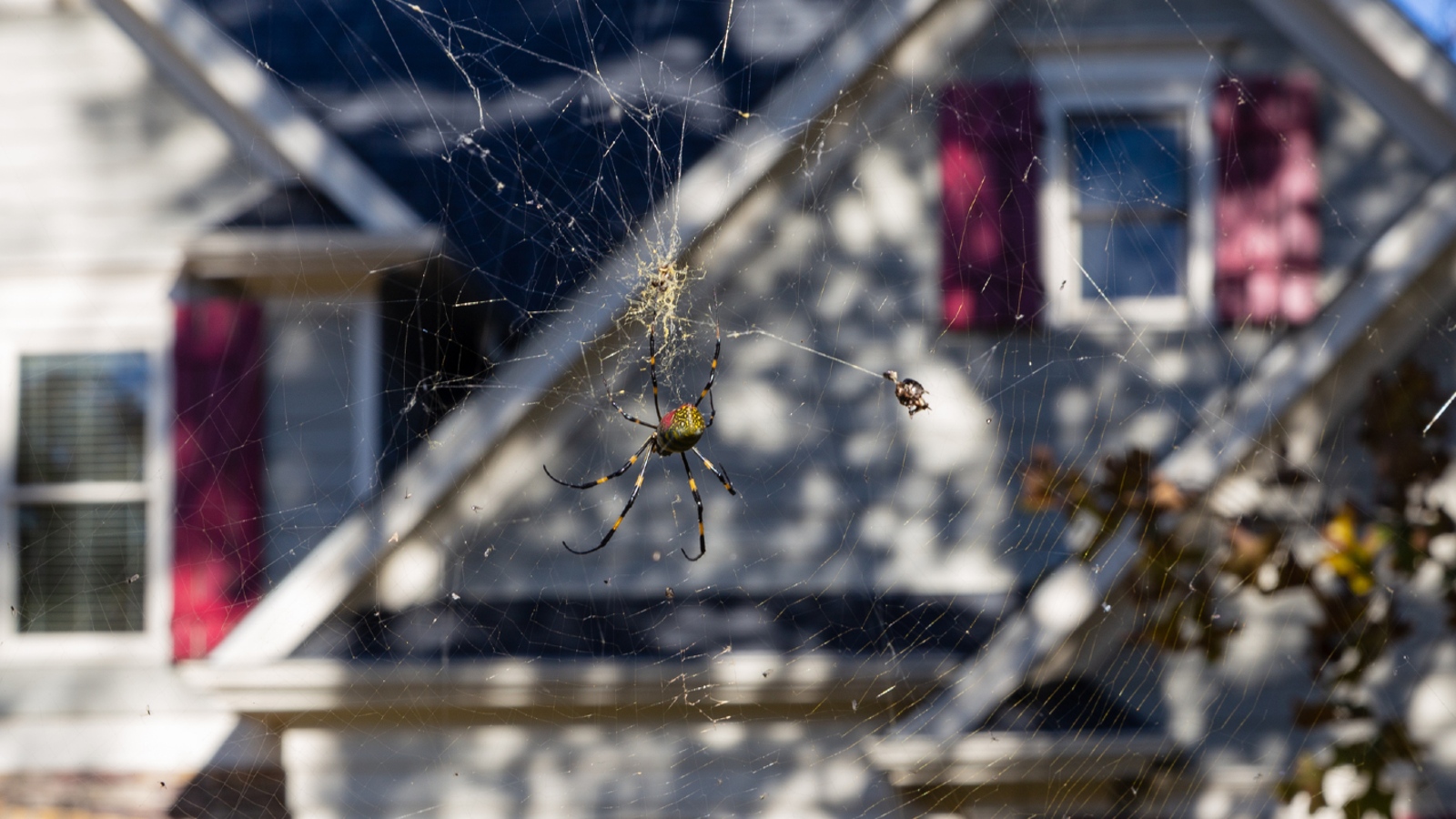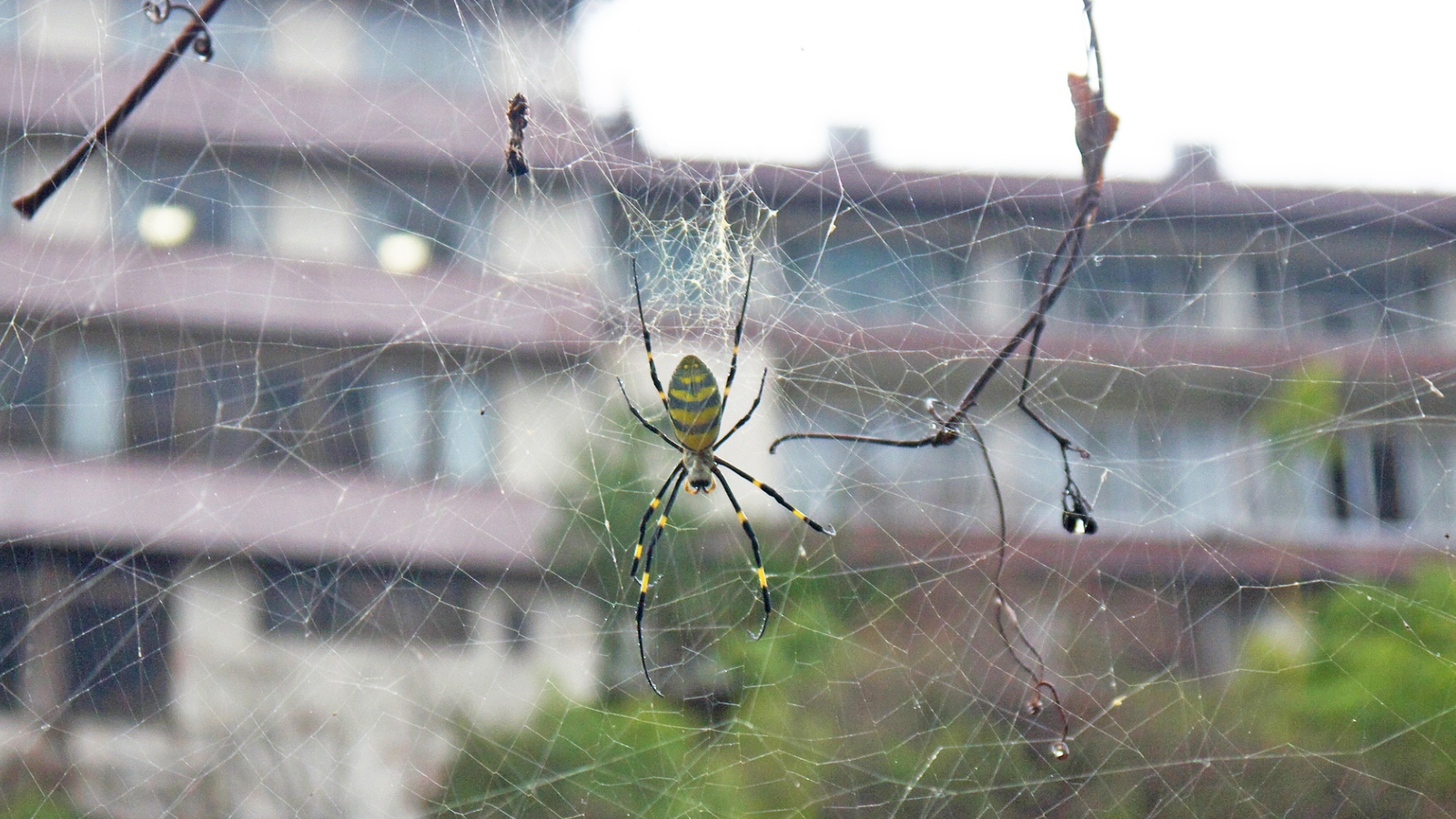Giant, invasive Joro spiders with 6-foot webs could be poised to take over US cities, scientists warn
A new study shows that invasive Joro spiders are surprisingly "urban tolerant," which could enable them to take over cities and other urban areas across the U.S. East Coast.

Giant, invasive Jorō spiders have spread across several U.S. states during the last decade. Now, scientists have discovered these palm-size critters are potentially much more tolerant to living in cities than other species and appear to thrive alongside major roads, which could help give them a foothold (or eight) in major cities along the Eastern Seaboard.
Jorō spiders (Trichonephila clavata) are a species of orb-weaving spiders — a group known for creating highly symmetrical, circular webs. Jorōs are easily recognizable thanks to the distinctive yellow bands that adorn their otherwise black legs. They also build unique webs that can be more than 6 feet (1.8 meters) across and appear golden when they reflect sunlight.
Female Jorōs, which can grow to around 3 inches (7.6 centimeters) across — around double the size of males — also have blue stripes and red patches on their predominantly yellow abdomens.
After mating in early autumn, female Jorōs lay large, web-bound clusters of up to 400 eggs before dying off at the start of winter, along with the males. When the eggs hatch in spring, the baby spiders create parachute-like webs that enable them to fly up to 100 miles (160 kilometers) away from where they were born.
Jorō spiders are endemic to Asia, and until recently they were only found in Japan, Korea, Taiwan and China. However, in 2014, researchers spotted several Jorōs in the U.S. near Atlanta, Georgia. Experts believe these invasive individuals were accidentally brought to the U.S. inside a shipping container, according to a 2015 study.
In the years since, Jorō spiders have quickly multiplied and spread in the U.S. thanks to their ability to widely disperse after birth. They are now found across Georgia, as well as in South Carolina, North Carolina and Tennessee. Additional sightings have also been reported in Alabama, Maryland, Oklahoma and West Virginia, and experts believe they could spread across the entire U.S. East Coast in the future.
Related: What is the deadliest spider in the world?
Get the world’s most fascinating discoveries delivered straight to your inbox.
Since their arrival, researchers have noticed that Jorō webs are often located in close proximity to major highways. This is surprising because the vibrations caused by busy roads normally interfere with spiders' ability to hunt: When smaller critters get trapped in spider webs, they struggle to get free, which alerts the spiders to their presence, but busy roads can drown out these vibrations. Spiders are also very sensitive to vibrations in general.
In a new study published Feb. 13 in the journal Arthropoda, researchers investigated how vibrations impacted Jorō spiders. In the laboratory, the study team used tuning forks to simulate the vibrations given off by highways to see how it impacted the arachnids' ability to hunt simulated prey placed in their webs.
Across 350 trials, vibrated Jorōs attacked simulated prey 59% of the time, while non-vibrated Jorōs pounced on the dummy prey 65% of the time. The trials also showed that the "roadside" spiders were able to maintain a similar healthy body weight to the other spiders, indicating that the vibrations were not impacting them in the long term.
"The spiders seem to be able to make a living there," lead study author Andy Davis, an ecologist at the University of Georgia, said in a statement. They are surprisingly "urban tolerant," he added.
It is unclear what long-term effects Jorō spiders will have on the ecosystems they invade. Last year, researchers revealed that the spiders are unusually shy and non-aggressive toward other spiders. However, without a natural predator seeking them out, their numbers will likely continue to rise, which could help them outcompete other species for resources.
But whatever their ecological effects, the new findings suggest these arachnid invaders aren't going anywhere anytime soon.
"I don't know how happy people are going to be about it, but I think the spiders are here to stay," study co-author Alexa Schultz, a third-year ecology student at the University of Georgia, said in the statement. And they could end up in places "where you wouldn’t imagine a spider to be," she added.

Harry is a U.K.-based senior staff writer at Live Science. He studied marine biology at the University of Exeter before training to become a journalist. He covers a wide range of topics including space exploration, planetary science, space weather, climate change, animal behavior and paleontology. His recent work on the solar maximum won "best space submission" at the 2024 Aerospace Media Awards and was shortlisted in the "top scoop" category at the NCTJ Awards for Excellence in 2023. He also writes Live Science's weekly Earth from space series.




